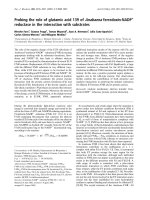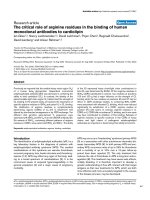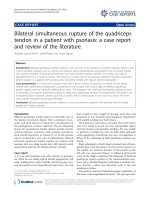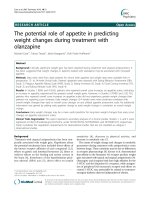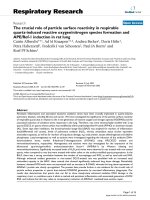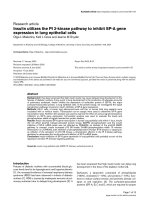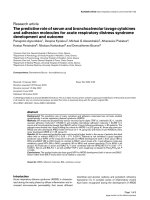Báo cáo y học: "Science review: Role of coagulation protease cascades in sepsis" ppt
Bạn đang xem bản rút gọn của tài liệu. Xem và tải ngay bản đầy đủ của tài liệu tại đây (89.51 KB, 8 trang )
123
APC = activated protein C; ATIII = antithrombin III; DEGR-Xa = dansyl-Glu-Gly-Arg-chloromethyl ketone modified Xa; EPCR = endothelial protein C
receptor; MCP = monocyte chemoattractant protein; PAR = protease-activated receptor; PC = protein C; TF, tissue factor; TFPI = tissue factor
pathway inhibitor; TNF = tumor necrosis factor; VIIa = coagulation factor VIIa; X/Xa = coagulation factor X/Xa.
Available online />Severe sepsis is an exceedingly common cause of death in
medical and surgical intensive care units. The sepsis syn-
drome involves a complex series of events that are caused by
an excessive stimulation of the innate immune system. During
the course of this dysregulation, the blood coagulation
cascade is triggered, leading to the clinical signs of dissemi-
nated intravascular coagulation and microvascular thrombo-
sis. Microvascular thrombosis is controlled by the
anticoagulant protein C (PC) pathway, and recombinant
human activated protein C (APC) has recently been approved
for the treatment of severe sepsis syndrome. There is increas-
ing preclinical and clinical evidence that proteases of the
coagulation system affect the inflammatory response, inde-
pendent of their role in initiating and controlling blood clot-
ting. Here, we review current concepts of the basic
mechanism of cell signaling by coagulation complexes. We
discuss the role of coagulation complexes in the inflammatory
dysregulation that occurs in sepsis and the implications of
these findings for anticoagulant therapy in septic patients.
Cell surface multiprotein complexes regulate
the blood coagulation cascade
A circulatory system requires mechanisms that prevent blood
loss, as well as those that counteract unwanted intravascular
obstructions in the form of thrombi. Hemostasis is initiated
and propagated through multiprotein complexes assembled
on the surface of cells (Fig. 1) [1,2]. Typically, these com-
plexes consist of a cofactor/receptor, an enzyme, and a sub-
strate moiety.
The coagulation cascade is initiated by the cell surface
receptor tissue factor (TF), which is expressed constitutively
by extravascular cells (pericytes, cardiomyocytes, smooth
muscle cells, keratinocytes) and by vascular monocytes and
endothelial cells upon induction by inflammatory cytokines or
endotoxin [3]. TF is the high-affinity cellular receptor for coag-
ulation factor VIIa (VIIa). In the absence of TF, VIIa has very
low catalytic activity, and binding to TF is necessary to render
Review
Science review: Role of coagulation protease cascades in sepsis
Matthias Riewald
1
and Wolfram Ruf
2
1
Senior Research Associate, Department of Immunology C204, The Scripps Research Institute, La Jolla, California USA
2
Associate Professor, Department of Immunology C204, The Scripps Research Institute, La Jolla, California USA
Correspondence: Wolfram Ruf,
Published online: 1 October 2002 Critical Care 2003, 7:123-129 (DOI 10.1186/cc1825)
This article is online at />© 2003 BioMed Central Ltd (Print ISSN 1364-8535; Online ISSN 1466-609X)
Abstract
Cellular signaling by proteases of the blood coagulation cascade through members of the protease-
activated receptor (PAR) family can profoundly impact on the inflammatory balance in sepsis. The
coagulation initiation reaction on tissue factor expressing cells signals through PAR1 and PAR2,
leading to enhanced inflammation. The anticoagulant protein C pathway has potent anti-inflammatory
effects, and activated protein C signals through PAR1 upon binding to the endothelial protein C
receptor. Activation of the coagulation cascade and the downstream endothelial cell localized
anticoagulant pathway thus have opposing effects on systemic inflammation. This dichotomy is of
relevance for the interpretation of preclinical and clinical data that document nonuniform responses to
anticoagulant strategies in sepsis therapy.
Keywords inflammatory balance, protein C, sepsis, tissue factor
124
Critical Care April 2003 Vol 7 No 2 Riewald and Ruf
VIIa functional by an allosteric mechanism [4]. The TF–VIIa
complex activates factor X (X) to Xa. Xa in turn is recruited to
its cofactor Va into the prothrombinase complex on platelets.
Platelets are essential to propagate a burst of thrombin gen-
eration that is dependent on procoagulant lipids typically
exposed on the surface of activated platelets. In a positive
feedback loop, thrombin activates the nonenzymatic cofactor
VIII to VIIIa, which binds factor IXa to form the intrinsic X acti-
vation complex. Additional Xa that is generated by this
complex amplifies the production of thrombin, which acts as
the central effector protease in hemostasis. Thrombin acti-
vates platelets, converts fibrinogen to fibrin, and promotes
fibrin cross-linking by activating factor XIII, leading to a stable
hemostatic plug at sites of interrupted vascular integrity
where TF is exposed on extravascular cells.
Sensitive markers of coagulation factor activation products
show that thrombin is generated at low levels within the vas-
culature under physiologic conditions and at increased rates
upon systemic stimulation by inflammatory cytokines, such as
tumor necrosis factor (TNF)-α, which upregulates TF in
endothelial cells and monocytes [2]. If the vascular integrity is
unperturbed, then low concentrations of intravascular throm-
bin do not precipitate a thrombotic response. Rather, throm-
bin activates the essential anticoagulant PC pathway [5], in
which APC degrades the cofactors Va and VIIIa on platelets
and endothelial cells. APC generation involves two endothe-
lial cell receptors, namely thrombomodulin and endothelial
PC receptor (EPCR). Thrombomodulin is a cofactor/receptor
for thrombin and changes thrombin’s specificity from pro-
coagulant functions to activation of PC [6]. EPCR is an
endothelial cell specific receptor for both PC and APC [7].
Recruitment of PC to EPCR enhances activation of PC by
thrombin–thrombomodulin, thus localizing the anticoagulant
pathway to the endothelial surface.
The biochemical mechanism of receptor-dependent activa-
tion of these enzyme cascades produces unique biologic
properties. For example, the initiating events and the down-
stream hemostatic response may become uncoupled under
certain circumstances in vivo. When healthy volunteers are
challenged with inflammatory cytokines, measurements of
Figure 1
Cell surface coagulation complexes of the procoagulant and anticoagulant pathways. The coagulation pathways are initiated by tissue factor (TF),
which serves as the allosteric activator of the enzyme coagulation factor VIIa (VIIa). The TF–VIIa complex binds substrate factor X (X) through
multiple contacts at so-called exosites, leading to the formation of a fairly stable TF–VIIa–X complex in which substrate X is converted to product
Xa. When Xa is released from this complex, it associates with the cofactor Va to form the Va–Xa (prothrombinase) complex, predominantly on
activated platelets that expose procoagulant phospholipid binding sites for Va and Xa. The intrinsic factor VIIIa–IXa complex can generate
additional Xa that further amplifies the burst of thrombin generation required for hemostasis. Cell surface receptor mediated events also govern
activation of the anticoagulant protein C (PC) pathway, which is localized to endothelial cells. Thrombomodulin (TM) binds thrombin and switches
the procoagulant properties of thrombin to anticoagulant functions. Endothelial PC receptor (EPCR) is the receptor for PC and activated protein C
(APC), and promotes activation of PC by thrombin–thrombomodulin. When APC is released from EPCR, it can act as a systemic anticoagulant by
cleaving cofactors Va and VIIIa on various cell types.
IIa
EPCR
APC
IIa
PC
TM
EPCR
TM
Quiescent Endothelial Cell
APC
II
Xa
Va
IXa
Platelet
X
VIIIa
IIa
VIIa
TF
VI
Ia
TF
Xa
VII/VIIa
X
TF
Extravascular Cell, Stimulated
Endothelial Cell or
Monocyte
Hemostasis
low
high
De
g
ra
d
a
t
i
o
n
o
f
V
a
a
n
d
V
I
II
a
IIa
VIIa
TF
X
Xa
125
activation peptides derived from X and prothrombin show that
increased Xa generation can occur without subsequent
thrombin generation [8]. The reason for this seemingly para-
doxic finding is the basic mechanism of how X is activated by
TF–VIIa. In the TF-initiated coagulation reaction, the TF–VIIa
complex binds substrate X and forms a ternary TF–VIIa–X
complex (Fig. 1). Only in this complex is the product Xa effi-
ciently generated. Xa has affinity for TF–VIIa and thus does
not dissociate immediately, but rather stays with TF in a
ternary TF–VIIa–Xa complex. Only upon dissociation from
TF–VIIa can Xa bind to Va and thus activate prothrombin. As
a consequence, if Xa does not dissociate from TF–VIIa, then
no thrombin is generated in vivo. The ternary TF–VIIa–Xa
complex is the target for physiologic regulation by TF
pathway inhibitor (TFPI), which simultaneously interacts with
VIIa and Xa to form a stable quaternary TF–VIIa–Xa–TFPI
complex [9]. Inhibition by TFPI provides the physiologic
mechanism that effectively counteracts subsequent thrombin
generation [10].
The concentration of circulating substrate X is sufficient to
saturate TF–VIIa, once the complex is exposed to the blood.
In contrast, substrate PC is typically preassembled with the
endothelial surface, because it binds efficiently to EPCR
under physiologic conditions (Fig. 1). When traces of
thrombin are trapped by endothelial cell thrombomodulin,
the thrombin–thrombomodulin complex activates PC bound
to EPCR. Because APC has similar affinity as PC for EPCR,
an early event in the anticoagulant pathway is to generate
APC that is associated with the endothelial cell surface.
Similar to Xa that is released from TF–VIIa–Xa, APC can
subsequently dissociate from EPCR and produce general-
ized anticoagulant effects by inactivating cofactors Va and
VIIIa on other cells. The procoagulant and anticoagulant
pathways thus initially generate cell surface associated pro-
teases that may serve functions other than hemostasis or
antithrombotic control. Of relevance for sepsis, the pro-
teases generated in the cellular context mediate cell signal-
ing, influencing the inflammatory balance within the
vasculature.
Protease-activated receptors mediate cell
signaling
in vivo
In order to adapt to their extracellular environment, living cells
have sensors for extracellular proteolytic activity, namely the
protease-activated receptors (PARs) [11,12]. PARs are
seven-transmembrane-domain, G-protein-coupled receptors,
and the activation mechanism for these receptors was first
established for the thrombin receptor PAR1. PARs are acti-
vated by cleavage of a specific arginyl peptide bond in the
amino-terminal ectodomain, leading to the exposure of a neo-
amino terminus that folds back and activates the receptor
(‘tethered ligand mechanism’). Proteases of the coagulation
system are the major activators of PARs, suggesting that
PARs have evolved to regulate cellular functions associated
with the response to vascular injury.
Of the four known human PARs, PAR1, PAR3, and PAR4 are
activated by thrombin. The physiologic importance of throm-
bin-dependent PAR signaling is clearly demonstrated by the
hemostatic defect of mice that lack the platelet expressed,
thrombin-sensing PAR4 [13]. PAR1 has been implicated as a
proinflammatory receptor in a thrombin-dependent model of
crescentic glomerulonephritis [14]. PAR2 is not directly acti-
vated by thrombin, but appears to be a less selective sensor
for several proteases, including trypsin and mast cell tryptase.
PAR2 is involved in leukocyte marginalization and extravasa-
tion [15,16] and can support inflammation by a neurogenic
mechanism [17], but anti-inflammatory effects were also
observed upon PAR2 stimulation [18]. These opposing
effects suggest that the specific response to PAR signaling
depends on the biologic context and the relevant activating
protease in these models of inflammation.
Role of coreceptors in protease-activated
receptor signaling by coagulation proteases
Although originally identified as the prototypical thrombin
receptor, PAR1 is recognized increasingly as a target for
other proteases. Unlike thrombin, most other proteases
depend on cofactors for the efficient cleavage of PAR1 and
PAR2 (Fig. 2). In recent studies [19–21] we analyzed the
specificity of PAR cleavage by coagulation complexes in
overexpression systems, as well as in primary endothelial
cells. Free Xa inefficiently cleaves PARs [19,22]. However, in
the TF-initiated coagulation reaction, Xa transiently bound in
the ternary TF–VIIa–Xa complex potently activates PAR1 and
PAR2 [20]. Neither Xa generated by the intrinsic activation
complex VIIIa–IXa nor Xa bound to Va signals efficiently
through PARs [19,20]. TF–VIIa can also activate PAR2
[20,22], but PAR activation by TF–VIIa is much less efficient
in comparison with the signaling of the ternary TF–VIIa–Xa
complex that is mediated by Xa. Thus, the TF-initiation reac-
tion produces highly efficient and specific signaling through
PARs.
These experiments lead to the novel concept that protease
signaling is mechanistically coupled and is an integrated part
of the TF-initiated coagulation pathway. Because downstream
coagulation is not triggered unless Xa is released from
TF–VIIa, coagulation protease signaling can occur early and
separately from massive activation of thrombin generation.
More importantly, inhibiting thrombin and blocking the
microthrombosis during disseminated intravascular coagula-
tion does not influence directly the early signaling events that
are solely dependent on the expression of TF by vascular and
extravascular cells.
The concept that cell signaling is coupled to the initiation of a
protease cascade may be extended to the anticoagulant
pathway (Fig. 2). PC bound to EPCR is activated by throm-
bin–thrombomodulin, but APC stays associated, at least tem-
porarily, with its endothelial cell receptor EPCR. EPCR serves
as an essential coreceptor in the activation of PAR1 and
Available online />126
PAR2 by APC in heterologous expression systems [21].
Physiologically relevant primary endothelial cells express both
PAR1 and PAR2 but, unlike the finding in heterologous
expression systems, APC selectively activates PAR1 in
endothelial cells [21]. The activation of the anticoagulant PC
pathway on endothelial cells is thus linked to EPCR-depen-
dent PAR1 signaling. Interestingly, EPCR is a major histo-
compatibility class I-like receptor closely related to CD1d
[23], whereas TF is related to interferon receptors [2]. The
cellular initiation of the procoagulant and anticoagulant path-
ways thus appears to have coevolved with the expansion of a
more complex immune system in vertebrates. That these
receptors orchestrate protease signaling through PARs indi-
cates potential immunomodulatory roles of protease complex
signaling.
Preclinical data indicate a separation of
thrombotic and inflammatory pathways
Given that the blood coagulation cascade is evolutionarily
closely related to enzyme cascades of the innate immune
response, it is not surprising that numerous molecular links
between coagulation and inflammation have been established
in vivo [24]. Inflammatory mediators not only promote coagu-
lation, but also the products of the coagulation system can in
turn profoundly affect the inflammatory response. Bacterial
septicemia has provided the most convincing example of an
association of the TF-initiated coagulation pathway with
inflammation in vivo. In a lethal baboon sepsis model, admin-
istration of inhibitors of the ternary TF–VIIa–Xa complex (e.g.
antibodies to TF, active site blocked VIIa, and TFPI) resulted
in marked reductions in mortality, along with therapeutic ben-
efits in reducing the ongoing coagulopathy [25–27].
However, lethality was not prevented by complete inhibition
of microthrombosis and consumptive coagulopathy with
DEGR-Xa, an active site-modified, inactive derivative of Xa
that binds to Va, and thus selectively and potently blocks
thrombin generation by the prothrombinase complex [28].
Conversely, producing disseminated intravascular coagula-
tion by infusion of purified TF does not recapitulate the proin-
flammatory effects that result from endotoxin-mediated
induction of the endogenous TF-driven coagulation pathways
[29]. Taken together, these findings strongly suggest that the
initiation phase of the coagulation pathways can sustain an
inflammatory lethal response, independent of the downstream
effector protease thrombin and coagulation-related effects.
The PC pathway also has anti-inflammatory effects that are
independent of its anticoagulant function. Early studies in
dogs demonstrated that infusion of thrombin blocks the lethal
inflammatory response to endotoxin [30]. Infusion of thrombin
into primates clearly demonstrated that low doses of throm-
bin act primarily as an anticoagulant by generating APC
without activating coagulation or platelets [5]. That thrombin-
dependent APC generation mediates protective effects in
sepsis models was convincingly shown by direct infusion of
APC into baboons challenged with Escherichia coli [31].
APC reduced coagulation abnormalities, organ failure, and
lethality. Because DEGR-Xa completely blocked the coagula-
tion abnormalities in the same sepsis model without reversing
lethality, the beneficial anti-inflammatory effects of APC must,
at least in part, be independent of its anticoagulant role. In
other models, APC reduced nitric-oxide-mediated hypoten-
sion and cytokine-mediated pulmonary or renal vascular injury
[32]. Again, anticoagulation with thrombin inhibition did not
exhibit the same beneficial effects, further supporting the
notion that anti-inflammatory effects of APC are independent
Critical Care April 2003 Vol 7 No 2 Riewald and Ruf
Figure 2
Coreceptor-dependent activation of protease-activated receptors (PARs) by coagulation proteases. Relevant signaling complexes are
schematically represented and the target PARs are listed. In primary endothelial cells, activated protein C (APC) signaling is mediated through
PAR1, whereas tissue factor (TF)–VIIa–Xa can signal when PAR1 is blocked, indicating signaling through PAR2. TF–VIIa inefficiently signals in
endothelial cells [20,22]. EPCR, endothelial protein C receptor; HUVEC, human umbilical vein endothelial cell.
TF-VIIa
TF
EPCR
-
Co-
receptor
yes
PAR1
PAR2
APC
yes
PAR1
PAR3
PAR4
Thrombin
no
no
Activation of
HUVECs PAR1-
dependent
PAR1
PAR2
Xa
PAR2
VIIa
Can
activate
VIIa
TF
Xa
VIIa
TF
EPCR
APC
IIa
TM
IIa
127
of its anticoagulant action. The preclinical evidence is thus
consistent with a physiologically relevant pathway in which
thrombin–thrombomodulin dependent APC generation trig-
gers protective anti-inflammatory effects in vivo. The recently
demonstrated clinical efficacy of APC in reducing lethality in
patients with severe sepsis [33] further emphasizes the
importance of the coagulation signaling mediated regulation
of inflammatory balance in clinical settings.
Protective effects of the activated protein
C–PAR1 signaling pathway
Several in vitro studies indicated that APC has anti-inflamma-
tory effects on monocytes and endothelial cells [34–37], but
the precise mechanism of action of APC remained unclear
and several studies had used supraphysiologic concentra-
tions of APC. Large scale expression profiling provided com-
pelling evidence that all gene induction events that follow
endothelial cell stimulation with low concentrations of APC
are mediated through activation of PAR1 [21]. PAR1-depen-
dent APC signaling induced a number of genes that are
known to downregulate proinflammatory signaling pathways
(e.g. TNF-α-induced protein A20, tristetraprolin) and that
counteract apoptosis (i.e. inhibitor of apoptosis protein 1,
Bcl2 homologue A1, GADD45B). Thus, the PC pathway on
endothelial cells can be considered an autocrine mechanism
that protects the endothelium from damage during ongoing
inflammation.
Gene expression profiling also showed that monocyte
chemoattractant protein (MCP)-1 (also known as
chemokine ligand 2) is upregulated by APC-mediated PAR1
signaling, but not by activation of PAR2, providing the first
example of a PAR-specific transcriptional response in
endothelial cells. The induction of MCP-1 by APC was a
puzzling observation, because MCP-1 can have proinflam-
matory effects by supporting local monocyte recruitment,
for example in lesion progression in arteriosclerosis [38,39].
However, in systemic inflammation, such as sepsis, adminis-
tration of MCP-1 is protective and neutralization of MCP-1
increases lethality in response to endotoxin challenge
[40,41]. MCP-1 acts on monocyte/macrophages to sup-
press proinflammatory interleukin-12 and TNF-α induction.
MCP-1 also targets T-cells to induce T-helper-2 polarization
and the associated upregulation of anti-inflammatory
cytokines interleukin-10 and interleukin-13 [38,39]. These
cytokines are crucial for control of the systemic inflamma-
tion that is responsible for the lethality in sepsis models
driven by local inflammation [42]. In contrast to the proin-
flammatory effects of local upregulation of MCP-1, systemic
upregulation of MCP-1 thus predominantly serves to coun-
teract exaggerated, systemic inflammatory responses. The
unique property of the APC–PAR1 pathway to induce
MCP-1 selectively in endothelial cells throughout the vascu-
lature may accomplish a systemic upregulation of MCP-1
that shifts the balance of the cytokine networks toward anti-
inflammatory and protective effects.
Proinflammatory effects of coagulation
protease signaling
Upon low-dose endotoxin stimulation monocytes rapidly
upregulate TF [43], but TF-directed inhibitors did not influ-
ence the cytokine response under these conditions [44]. In
contrast, inhibitors of the TF-initiation complex reduce pro-
inflammatory cytokines such as interleukin-6 in lethal sepsis
models induced by high-dose endotoxin [26,27], indicating
that signaling by coagulation proteases contributes only to
exacerbated cytokine production, and not to the initial inflam-
matory response. In lethal primate models of septicemia, TF is
upregulated in endothelial cells of the marginal zone of the
spleen, in alveolar lung epithelial cells, splenic macrophages,
and renal glomeruli epithelial cells [45]. Multiple intravascular
and extravascular cell types can therefore contribute to the
TF-driven escalation in the inflammatory response. In the
escalation of sepsis, the vascular permeability changes may
lead to an increasing contribution of extravascular cells to the
proinflammatory effects. The seemingly paradoxic finding that
coagulation protease mediated PAR signaling influences both
the proinflammatory and anti-inflammatory response may be
explained, in part, by the fact that TF-dependent signaling
activates multiple cell types, whereas APC signaling is
endothelial cell restricted.
Implications for the use of anticoagulants in
sepsis therapy
The described mechanisms by which the procoagulant and
anticoagulant pathways regulate the inflammatory balance in
vivo add new aspects of how to approach anticoagulant
therapy in septic patients. Inhibitors of the TF-initiation
complex are expected to block the proinflammatory signaling
of the initiation reaction and thus have anti-inflammatory ben-
efits that are not recapitulated by anticoagulants that target
thrombin, a notion that is supported by several preclinical
studies [25–27,46] (Fig. 3). Antithrombin III (ATIII) can inhibit
TF–VIIa, in addition to Xa and thrombin. In the absence of
heparin, antithrombin can bind to cell-surface proteoglycans
and thereby act as an inhibitor of membrane-associated sig-
naling complexes. Consistent with this notion, recombinant
ATIII attenuates the inflammatory response and improves sur-
vival similar to other direct TF inhibitors in lethal, preclinical
sepsis models [47].
In a large clinical sepsis trial, however, ATIII’s benefit in
improving 90-day survival was reversed in patients receiving
heparin therapy [48]. Heparin displaces ATIII from cell sur-
faces where coagulation signaling complexes are expressed,
and it enhances the inhibitory activity of ATIII toward the fluid-
phase protease thrombin. One may expect anti-inflammatory
benefits from such enhanced thrombin inhibition through the
suppression of fibrin deposition, of leukocyte recruitment to
sites of inflammation, and of resulting microcirculatory dys-
function. However, these beneficial effects may be entirely
negated by the concomitant reduction in thrombin-dependent
APC generation and APC-mediated protective signaling.
Available online />128
There is evidence that the physiologic protective PC pathway is
progressively downregulated in sepsis, predominantly through
a loss of thrombomodulin and, less pronounced, of EPCR from
endothelial cells [49]. APC therapy may rescue the disabled
APC pathway in severe sepsis and restore anti-inflammatory
APC–PAR1 signaling by utilizing residually expressed EPCR.
Notably, blocking EPCR in preclinical sepsis models worsened
the inflammation and increased lethality [50]. The clinical
observation that only patients with severe sepsis benefited
from APC therapy [33] is consistent with the notion that a
physiologic protective pathway becomes progressively dis-
abled in the escalation of sepsis syndrome. Anticoagulants that
target the TF-pathway directly may provide additional benefit in
reducing the inflammatory response. Whether upstream coagu-
lation inhibitors can be clinically applied without disabling the
protective PC pathway remains an open question.
The concept is emerging that proinflammatory and anti-
inflammatory signaling is separable from the hemostatic
response. This concept has implications for potential future
improvements in anti-inflammatory therapy targeting the coag-
ulation pathways. For example, APC may be engineered to
have reduced activity toward degradation of factors Va
and/or VIIIa, or increased affinity for EPCR, resulting in more
efficient EPCR-dependent protective signaling in endothelial
cells with reduced bleeding complications. Similarly, tailoring
inhibitors to specifically reduce signaling by the TF-initiated
coagulation complex may yield partial anticoagulants that
allow for the release of sufficient quantities of Xa to yield a
hemostatic response, while simultaneously controlling the
escalation of the inflammatory cytokine response in sepsis.
Conclusion
The recent appreciation of cell signaling as a physiological
component of the pro- and anticoagulant pathways has pro-
vided a mechanistic understanding for the anti-inflammatory
effects of APC in septicemia. Coagulation protease signaling
through PARs appears to play an important immuno-modula-
tory role during systemic inflammation. The elucidation of
basic principles of signaling of the pro- and anticoagulant
pathways has far reaching implications for strategies in sepsis
therapy that target the coagulation system.
Competing interests
None declared.
References
1. Mann KG, Nesheim ME, Church WR, Haley P, Krishnaswamy S:
Surface-dependent reactions of the vitamin K-dependent
enzyme complexes. Blood 1990, 76:1-16.
2. Ruf W, Edgington TS: Structural biology of tissue factor, the
initiator of thrombogenesis in vivo. FASEB J 1994, 8:385-390.
3. Drake TA, Morrissey JH, Edgington TS: Selective cellular
expression of tissue factor in human tissues. Am J Pathol
1989, 134:1087-1097.
4. Ruf W, Dickinson CD: Allosteric regulation of the cofactor-
dependent serine protease coagulation factor VIIa. Trends
Cardiovasc Med 1998, 8:350-356.
5. Hanson SR, Griffin JH, Harker LA, Kelly AB, Esmon CT, Gruber A:
Antithrombotic effects of thrombin-induced activation of
endogenous protein C in primates. J Clin Invest 1993, 92:
2003-2012.
6. Esmon CT: Thrombomodulin as a model of molecular mecha-
nisms that modulate protease specificity and function at the
vessel surface. FASEB J 1995, 9:946-955.
7. Esmon CT, Xu J, Gu JM, Qu D, Laszik Z, Ferrell G, Stearns-Kuro-
sawa DJ, Kurosawa S, Taylor FB Jr, Esmon NL: Endothelial
protein C receptor. Thromb Haemost 1999, 82:251-258.
Critical Care April 2003 Vol 7 No 2 Riewald and Ruf
Figure 3
Targets of anticoagulant therapy and their efficacy in providing anti-inflammatory benefit in sepsis. Anticoagulants (shown in red and boxed)
showed preclinical efficacy in preventing lethality, whereas anticoagulant mechanisms (shown in blue and circled) failed to protect in sepsis. ATIII,
antithrombin III; TF, tissue factor; TFPI, tissue factor pathway inhibitor.
TF–VIIa–X
Xa
Va–Xa
IIa
Fibrinogen
Platelets
APC
Inflammatory
Signaling
Protective
Signaling
TF–VIIa–Xa
TF
TF–VIIa
VIIai
anti-TF
ATIII
TFPI
Hemostasis
Thrombosis
ATIII
heparin
Xai
ATIII
heparin
129
8. Van der Poll T, Büller HR, Ten Cate H, Wortel CH, Bauer KA, Van
Deventer SJH, Hack CE, Sauerwein HP, Rosenberg RD, Ten Cate
JW: Activation of coagulation after administration of tumor
necrosis factor to normal subjects. N Engl J Med 1990, 322:
1622-1627.
9. Baugh RJ, Broze GJ Jr, Krishnaswamy S: Regulation of extrinsic
pathway factor Xa formation by tissue factor pathway
inhibitor. J Biol Chem 1998, 273:4378-4386.
10. Huang Z-F, Higuchi D, Lasky N, Broze GJ Jr: Tissue factor
pathway inhibitor gene disruption produces intrauterine
lethality in mice. Blood 1997, 90:944-951.
11. Coughlin SR: Thrombin signalling and protease-activated
receptors. Nature 2000, 407:258-264.
12. O’Brien PJ, Molino M, Kahn M, Brass LF: Protease activated
receptors: theme and variations. Oncogene 2001, 20:1570-
1581.
13. Sambrano GR, Weiss EJ, Zheng Y-W, Coughlin SR: Role of
thrombin signalling in platelets in haemostasis and thrombo-
sis. Nature 2001, 413:26-27.
14. Cunningham MA, Rondeau E, Chen X, Coughlin SR, Holdsworth
SR, Tipping PG: Protease-activated receptor 1 mediates
thrombin-dependent, cell-mediated renal inflammation in
crescentic glomerulonephritis. J Exp Med 2000, 191:455-462.
15. Lindner JR, Kahn ML, Coughlin SR, Sambrano GR, Schauble E,
Bernstein D, Foy D, Hafezi-Moghadam A, Ley K: Delayed onset
of inflammation in protease-activated receptor-2-deficient
mice. J Immunol 2000, 165:6504-6510.
16. Vergnolle N:Proteinase-activated receptor-2-activating pep-
tides induce leukocyte rolling, adhesion, and extravasation in
vivo. J Immunol 1999, 163:5064-5069.
17. Steinhoff M, Vergnolle N, Young SH, Tognetto M, Amadesi S,
Ennes HS, Trevisani M, Hollenberg MD, Wallace JL, Caughey GH,
Mitchell SE, Williams LM, Geppetti P, Mayer EA, Bunnett NW:
Agonists of proteinase-activated receptor 2 induce inflamma-
tion by a neurogenic mechanism. Nature Med 2000, 6:151-
158.
18. Cocks TM, Fong B, Chow JM, Anderson GP, Frauman AG, Goldie
RG, Henry PJ, Carr MJ, Hamilton JR, Moffatt JD: A protective role
for protease-activated receptors in the airways. Nature 1999,
398:156-160.
19. Riewald M, Kravchenko VV, Petrovan RJ, O’Brien PJ, Brass LF,
Ulevitch RJ, Ruf W: Gene induction by coagulation factor Xa is
mediated by activation of PAR-1. Blood 2001, 97:3109-3116.
20. Riewald M, Ruf W: Mechanistic coupling of protease signaling
and initiation of coagulation by tissue factor. Proc Natl Acad
Sci USA 2001, 98:7742-7747.
21. Riewald M, Petrovan RJ, Donner A, Mueller BM, Ruf W: Activa-
tion of endothelial cell protease activated receptor 1 by the
protein C pathway. Science 2002, 296:1880-1882.
22. Camerer E, Huang W, Coughlin SR: Tissue factor- and factor X-
dependent activation of protease-activated receptor 2 by
factor VIIa. Proc Natl Acad Sci USA 2000, 97:5255-5260.
23. Oganesyan V, Oganesyan N, Terzyan S, Qu D, Dauter Z, Esmon
NL, Esmon CT: The crystal structure of the endothelial protein
C receptor and a bound phospholipid. J Biol Chem 2002, 277:
24851-24854.
24. Opal SM: Phylogenetic and functional relationships between
coagulation and the innate immune response. Crit Care Med
2000, 28(suppl):S77-S80.
25. Taylor FB Jr, Chang A, Ruf W, Morrissey JH, Hinshaw L, Catlett R,
Blick K, Edgington TS: Lethal E. coli septic shock is prevented
by blocking tissue factor with monoclonal antibody. Circ
Shock 1991, 33:127-134.
26. Creasey AA, Chang ACK, Feigen L, Wun T-C, Taylor FB Jr,
Hinshaw LB: Tissue factor pathway inhibitor (TFPI) reduces
mortality from E. coli septic shock. J Clin Invest 1993, 91:
2850-2860.
27. Taylor FB Jr, Chang ACK, Peer G, Li A, Ezban M, Hedner U:
Active site inhibited factor VIIa (DEGR VIIa) attenuates the
coagulant and interleukin-6 and -8, but not tumor necrosis
factor, responses of the baboon to LD
100
Escherichia coli.
Blood 1998, 91:1609-1615.
28. Taylor FB Jr, Chang ACK, Peer GT, Mather T, Blick K, Catlett R,
Lockhart MS, Esmon CT: DEGR-factor Xa blocks dissemi-
nated intravascular coagulation initiated by Escherichia coli
without preventing shock or organ damage. Blood 1991, 78:
364-368.
29. Asakura H, Suga Y, Aoshima K, Ontachi Y, Mizutani T, Kato M,
Saito M, Morishita E, Yamazaki M, Takami A, Miyamoto K-I, Nakao
S: Marked difference in pathophysiology between tissue
factor- and lipopolysaccharide-induced disseminated intra-
vascular coagulation models in rats. Crit Care Med 2002, 30:
161-164.
30. Taylor FB Jr, Chang A, Hinshaw LB, Esmon CT, Archer LT, Beller
BK: A model for thrombin protection against endotoxin.
Thromb Res 1984, 36:177-185.
31. Taylor FB, Chang A, Esmon CT, D’Angelo A, Vigano-D’Angelo S,
Blick KE: Protein C prevents the coagulopathic and lethal
effects of Escherichia coli infusion in the baboon. J Clin Invest
1987, 79:918-925.
32. Isobe H, Okajima K, Uchiba M, Mizutani A, Harada N, Nagasaki A,
Okabe K: Activated protein C prevents endotoxin-induced
hypotension in rats by inhibiting excessive production of nitric
oxide. Circulation 2001, 104:1171-1175.
33. Bernard GR, Vincent JL, Laterre PF, LaRosa SP, Dhainaut JF,
Lopez-Rodriguez A, Steingrub JS, Garber GE, Helterbrand JD, Ely
EW, Fisher CJ Jr: Efficacy and safety of recombinant human
activated protein C for severe sepsis. N Engl J Med 2001, 344:
759-762.
34. Shu F, Kobayashi H, Fukudome K, Tsuneyoshi N, Kimoto M, Terao
T: Activated protein C suppresses tissue factor expression on
U937 cells in the endothelial protein C receptor-dependent
manner. FEBS Lett 2000, 477:208-212.
35. Grey ST, Tsuchida A, Hau H, Orthner CL, Salem HH, Hancock
WW: Selective inhibitory effects of the anticoagulant acti-
vated protein C on the responses of human mononuclear
phagocytes to LPS, IFN-
γγ
, or phorbol ester. J Immunol 1994,
153:3664-3672.
36. White B, Schmidt M, Murphy C, Livingstone W, O’Toole D, Lawler
M, O’Neill L, Kelleher D, Schwarz HP, Smith OP: Activated
protein C inhibits lipopolysaccharide-induced nuclear translo-
cation of nuclear factor kappaB (NF-kappaB) and tumour
necrosis factor
αα
(TNF-
αα
) production in the THP-1 monocytic
cell line. Br J Haematol 2000, 110:130-134.
37. Joyce DE, Gelbert L, Ciaccia A, DeHoff B, Grinnell BW: Gene
expression profile of antithrombotic protein C defines new
mechanisms modulating inflammation and apoptosis. J Biol
Chem 2001, 276:11199-11203.
38. Luther SA, Cyster JG: Chemokines as regulators of T cell dif-
ferentiation. Nature Immunology 2001, 2:102-107.
39. Gerard C, Rollins B: Chemokines and disease. Nat Immunol
2001, 2:108-115.
40. Zisman DA, Kunkel SL, Tsai WC, Bucknell K, Wilkowski J, Standi-
ford TJ: MCP-1 protects mice in lethal endotoxemia. J Clin
Invest 1997, 99:2832-2836.
41. Bone-Larson CL, Hogaboam CM, Steinhauser ML, Oliveira SH,
Lukacs NW, Strieter RM, Kunkel SL: Novel protective effects of
stem cell factor in a murine model of acute septic peritonitis.
Dependence on MCP-1. Am J Pathol 2000, 157:1177-1186.
42. Walley KR, Lukacs NW, Standiford TJ, Strieter RM, Kunkel SL:
Balance of inflammatory cytokines related to severity and
mortality of murine sepsis. Infect Immun 1996, 64:4733-4738.
43. Franco RF, De Jonge E, Dekkers PEP, Timmerman JJ, Spek CA,
Van Deventer SJH, Van Deursen P, Van Kerkhoff L, Van Gemen B,
Ten Cate H, Van der Poll T, Reitsma PH: The in vivo kinetics of
tissue factor messenger RNA expression during human endo-
toxemia: relationship with activation of coagulation. Blood
2000, 96:554-559.
44. De Jonge E, Dekkers PEP, Creasey AA, Hack CE, Paulson SK,
Karim A, Kesecioglu J, Levi M, Van Deventer SJH, Van der Poll T:
Tissue factor pathway inhibitor dose-dependently inhibits
coagulation activation without influencing the fibrinolytic and
cytokine response during human endotoxemia. Blood 2000,
95:1124-1129.
45. Drake TA, Cheng J, Chang A, Taylor FB Jr: Expression of tissue
factor, thrombomodulin, and E-selectin in baboons with lethal
E. coli sepsis. Am J Pathol 1993, 142:1458-1470.
46. Miller DL, Welty-Wolf K, Carraway MS, Ezban M, Ghio A, Suliman
H, Piantadosi CA: Extrinsic coagulation blockade attenuates
lung injury and proinflammatory cytokine release after intra-
tracheal lipopolysaccharide. Am J Respir Cell Mol Biol 2002,
26:650-658.
47. Minnema MC, Chang ACK, Jansen PM, Lubbers YTP, Pratt BM,
Whittaker BG, Taylor FB, Hack CE, Friedman B: Recombinant
Available online />130
human antithrombin III improves survival and attenuates
inflammatory responses in baboons lethally challenged with
Escherichia coli. Blood 2000, 95:1117-1123.
48. Warren BL, Eid A, Singer P, Pillay SS, Carl P, Novak I, Chalupa P,
Atherstone A, Penzes I, Kubler A, Knaub S, Keinecke HO, Hein-
richs H, Schindel F, Juers M, Bone RC, Opal SM: Caring for the
critically ill patient. High-dose antithrombin III in severe
sepsis: a randomized controlled trial. JAMA 2001, 286:1869-
1878.
49. Faust SN, Levin M, Harrison OB, Goldin RD, Lockhart MS, Kon-
daveeti S, Laszik Z, Esmon CT, Heyderman RS: Dysfunction of
endothelial protein C activation in severe meningococcal
sepsis. N Engl J Med 2001, 345:408-416.
50. Taylor FB Jr, Stearns-Kurosawa DJ, Kurosawa S, Ferrell G, Chang
ACK, Laszik Z, Kosanke S, Peer G, Esmon CT: The endothelial
cell protein C receptor aids in host defense against
Escherichia coli sepsis. Blood 2000, 95:1680-1686.
Critical Care April 2003 Vol 7 No 2 Riewald and Ruf


